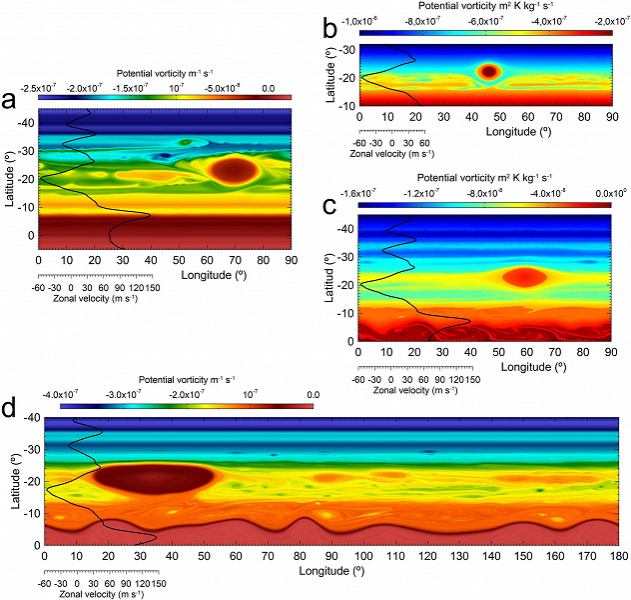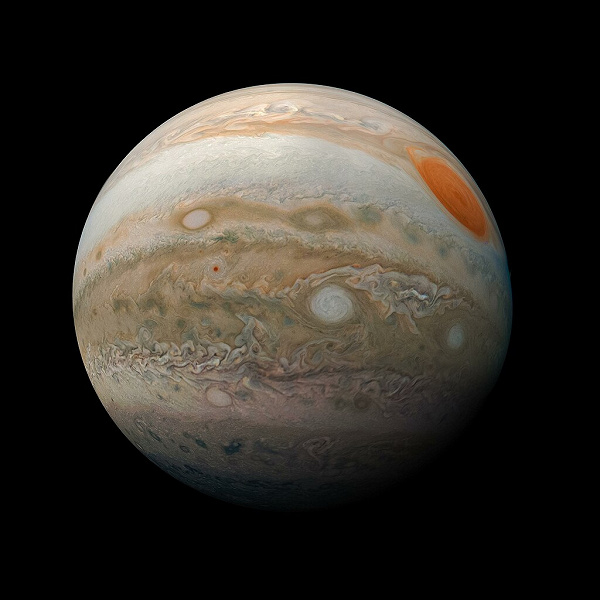The history of the solar system's most famous vortex becomes clearer
Researchers at the University of the Basque Country (UPV/EHU), the Polytechnic University of Catalonia BarcelonaTech (UPC) and the Barcelona Supercomputing Center (CNS-BSC) have conducted a comprehensive study of Jupiter's Great Red Spot. They analyzed historical observations dating back to the 17th century and developed numerical models to explain the duration and nature of this unique atmospheric formation.
Jupiter's Great Red Spot (GRS) is one of the most famous and recognizable atmospheric structures in the Solar System. Its striking size (currently the diameter of GRS is equal to the diameter of the Earth) and reddish color, standing out against the background of the pale clouds of the planet, make it clearly visible even in small telescopes.
GRS is a giant anticyclonic vortex, along the periphery of which winds blow at speeds of up to 450 km/h. This is the largest and oldest vortex that exists in the atmospheres of the planets of the solar system. However, its age remains a subject of debate, and the mechanism that led to its formation is still not completely clear.
The roots of speculation about the origin of the GRS go back to the first telescopic observations made by astronomer Giovanni Domenico Cassini in 1665. Then Cassini discovered a dark oval object at the same latitude as the modern GRS, and called it the «Permanent Spot» (PS), since this formation was observed by him and other astronomers until 1713.
Then astronomers lost track of PS for 118 years, until in 1831 and in subsequent years S. Schwabe again recorded a clear oval structure coinciding in latitude with GRS. This could be considered the first observation of the current Great Red Spot, possibly in its formative stages. Since then, the GRS has been continuously observed by ground-based telescopes and various space missions that have visited Jupiter.
In the study, the authors analyzed the evolution of the size, structure and movements of both the Permanent Spot observed by Cassini and the modern Great Red Spot. To do this, they used historical sources dating back to the mid-17th century, shortly after the invention of the telescope.
«Our measurements of size and motion characteristics convincingly show that the current Great Red Spot is unlikely to be the same Permanent Spot observed by Cassini. Most likely, the Permanent Spot disappeared sometime between the mid-18th and 19th centuries, in which case the modern Red Spot has been around for at least 190 years, — explained Agustin Sánchez-Lavega, professor of physics at UPV/EHU who led this research.
Interestingly, the size of the Red Spot, which was about 39,000 kilometers in 1879 along its long axis, has decreased over time to about 14,000 kilometers, while it has become more rounded.
In addition, since the 1970s, this unique meteorological phenomenon on Jupiter has been carefully studied during a number of space missions.
Recently, various instruments on board the Juno space mission, orbiting Jupiter, have shown that the Great Red Spot is a relatively shallow and thin feature compared to its horizontal dimensions. Its vertical length is about 500 kilometers, as explained by Agustin Sanchez-Lavega.
To understand how this giant atmospheric vortex could have formed, research teams from UPV/EHU and UPC carried out numerical simulations on supercomputers such as MareNostrum IV at the Barcelona Supercomputing Center (BSC), part of the Spanish Supercomputing Network (RES). Scientists used two complementary types of models to study the behavior of thin vortices in Jupiter's atmosphere.
On this planet, powerful wind currents prevail, which flow along parallels, changing their direction with latitude. North of the Great Red Spot, winds blow to the west at 180 km/h, and south to the east at 150 km/h. This huge shift in wind speed from north to south is the key factor allowing the vortex to grow.

The study looked at various mechanisms that could explain the origin of the Great Red Spot, including the possibility of it arising from a giant superstorm like those occasionally seen on twin planet Saturn, or the merger of many smaller vortices caused by wind shear. However, the results showed that although in both cases an anticyclonic vortex can form, its characteristics in shape and dynamics will still differ from the modern Great Red Spot.
«We also believe that if one of these unusual phenomena had occurred, then astronomers of the time would undoubtedly have recorded it or its consequences in the atmosphere», — Sanchez-Lavega said.
In a third series of numerical experiments, the research team examined the possibility of the Great Red Spot being generated due to known wind instability, which is believed to be capable of creating an elongated region surrounding and trapping these winds. Such a region could represent an incipient Red Spot, the subsequent contraction of which would lead to the appearance of the compact and rapidly rotating Great Red Spot observed in the late 19th century. The formation of large elongated regions has already been observed during the emergence of other powerful vortices on Jupiter.
«Our supercomputer simulations showed that elongated cells would be stable if they rotated around the periphery of the Great Red Spot at speeds matching the winds on Jupiter, as expected if they formed from – behind this instability», — explained study co-author Enrique Garcia-Melendo.
Using two different numerical modeling approaches, the researchers concluded that if the Red Spot's rotation speed was slower than the surrounding winds, it would disintegrate, making it impossible for a stable vortex to form. And if the speed is too high, then its properties will differ from the characteristics of the Great Red Spot observed today.
Future research will attempt to replicate the shrinking size of the Great Red Spot over time to further elucidate the physical mechanisms underlying its longevity. Scientists will also try to predict whether the Great Red Spot will disintegrate and disappear when it reaches its extreme size, as could happen with the Persistent Spot observed by Cassini, or whether it will stabilize at some size limit and can continue to exist for many years to come. < /p>

